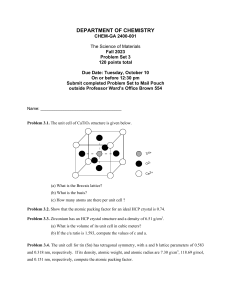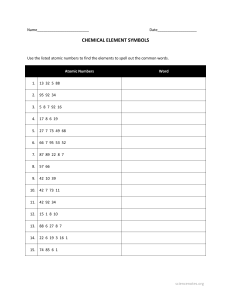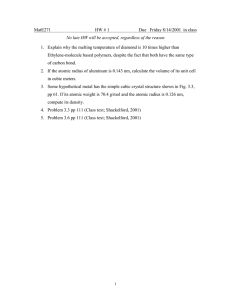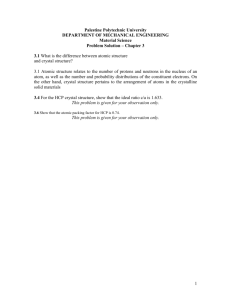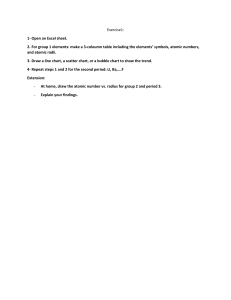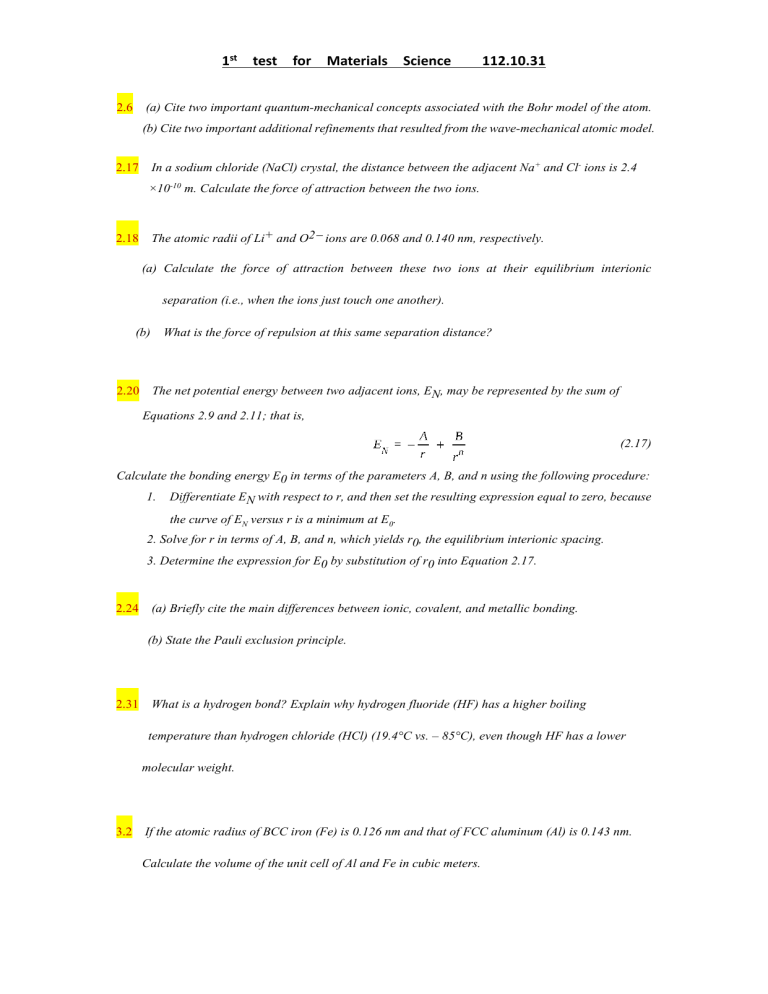
1st test 2.6 for Materials Science 112.10.31 (a) Cite two important quantum-mechanical concepts associated with the Bohr model of the atom. (b) Cite two important additional refinements that resulted from the wave-mechanical atomic model. In a sodium chloride (NaCl) crystal, the distance between the adjacent Na+ and Cl- ions is 2.4 2.17 ×10-10 m. Calculate the force of attraction between the two ions. The atomic radii of Li+ and O2− ions are 0.068 and 0.140 nm, respectively. 2.18 (a) Calculate the force of attraction between these two ions at their equilibrium interionic separation (i.e., when the ions just touch one another). (b) 2.20 What is the force of repulsion at this same separation distance? The net potential energy between two adjacent ions, EN, may be represented by the sum of Equations 2.9 and 2.11; that is, (2.17) Calculate the bonding energy E0 in terms of the parameters A, B, and n using the following procedure: 1. Differentiate EN with respect to r, and then set the resulting expression equal to zero, because the curve of EN versus r is a minimum at E0. 2. Solve for r in terms of A, B, and n, which yields r0, the equilibrium interionic spacing. 3. Determine the expression for E0 by substitution of r0 into Equation 2.17. 2.24 (a) Briefly cite the main differences between ionic, covalent, and metallic bonding. (b) State the Pauli exclusion principle. 2.31 What is a hydrogen bond? Explain why hydrogen fluoride (HF) has a higher boiling temperature than hydrogen chloride (HCl) (19.4°C vs. – 85°C), even though HF has a lower molecular weight. 3.2 If the atomic radius of BCC iron (Fe) is 0.126 nm and that of FCC aluminum (Al) is 0.143 nm. Calculate the volume of the unit cell of Al and Fe in cubic meters. 3.5 Draw the HCP crystal structure and show the [0001] and [11� 00] directions. For the HCP crystal structure, show that the ideal c/a ratio is 1.633. 3.12 Zirconium (Zr) and titanium (Ti) have an HCP crystal structure. Zr has a density of 6.51 g/cm3 and Ti has a density of 4.5 g/cm3. (a) What is the volume of their unit cell in cubic meters? (b) If the c/a ratio of Zr is 1.593 and that of Ti is 1.587, compute the values of c and a. 3.13 Cobalt (Co) has an HCP crystal structure and a density of 8.86 g/cm3. (a) What is the volume of its unit cell in cubic meters? (b) If the c/a ratio is 1.623, compute the values of c and a. 3.15 Rhodium (Rh) has an atomic radius of 0.1345 nm and a density of 12.41 g/cm3. Iron (Fe) has an atomic radius of 0.126 nm and a density of 7.87 g/cm3. Determine whether the crystal structure of Rh and Fe is FCC or BCC crystal structure. 3.16 The atomic weight, density, and atomic radius for three hypothetical alloys are listed in the following table. For each determine whether its crystal structure is FCC, BCC, or simple cubic and then justify your determination. Alloy Atomic Weight Density Atomic Radius (g/mol) (g/cm3) (nm) A 77.4 8.22 0.125 B 107.6 13.42 0.133 C 127.3 9.23 0.142 3.21 Cadmium (Cd) has an HCP crystal structure, an atomic radius of 0.149 nm, and a c/a ratio of 1.886. Rhenium (Re) also has an HCP structure, an atomic radius of 0.137 nm and a c/a ratio of 1.615. Compute the volumes of the unit cell for Cd and Re. 3.30 Compute the atomic packing factor for sodium chloride (NaCl) and cesium chloride (CsCl) using the ionic radii in Table 3.4 and assuming that the ions touch along the cube diagonals. 3.34 (a) Using the ionic radii in Table 3.4, compute the theoretical density of CsCl. (Hint: Use a modified form of Equation 3.4.) (b) The measured density is 3.99 g/cm3. How do you explain the slight discrepancy between your calculated value and the measured one? 3.42 Compute the atomic packing factor for the diamond cubic crystal structure (Figure 3.17). Assume that bonding atoms touch one another, that the angle between adjacent bonds is 109.5°, and that each atom internal to the unit cell is positioned a/4 of the distance away from the two nearest cell faces (a is the unit cell edge length). 3.70 Sketch and determine the planar density of (a) the (100) plane for the BCC crystal structure, (b) the (111) plane for the FCC crystal structure, and (c) the (010) plane of the simple cubic crystal structure. 3.79 (a) Draw the BCC [100], [110] and [111] directions in a unit cell and derive the linear density expressions for terms of the atomic radius R. (b) Compute and compare linear density values for these same two directions for iron (Fe). 3.81 (a) Derive planar density expressions for BCC (110), (011) and (101) planes in terms of the atomic radius R. (b) Compute and compare planar density values for these planes for vanadium (V) and iron (Fe). 3.87 What are polycrystalline materials? Explain why the properties of polycrystalline materials are most often isotropic. 3.90 Using the data for nickel (Ni) and aluminum (Al) in Table 3.1, compute the interplanar spacings for the (110) and (221) sets of planes. 3.94 The metal rubidium has a BCC crystal structure. If the angle of diffraction for the (321) set of planes occurs at 27.00° (first-order reflection) when monochromatic x-radiation having a wavelength of 0.0711 nm is used, compute (a) the interplanar spacing for this set of planes, and (b) the atomic radius for the rubidium atom. 3.97 Figure 3.45 shows the first four peaks of the x-ray diffraction pattern for copper, which has an FCC crystal structure; monochromatic x-radiation having a wavelength of 0.1542 nm was used. (a) Index (i.e., give h, k, and l indices) for each of these peaks. (b) Determine the interplanar spacing for each of the peaks. (c) For each peak, determine the atomic radius for Cu and compare these with the value presented in Table 3.1. 4.5 The following table lists molecular weight data for a polypropylene material. Compute the following: (a) the number-average molecular weight (b) the weight-average molecular weight, and (c) the degree of polymerization. Molecular Weight Range (g/mol) xi wi 8,000–16,000 0.05 0.02 16,000–24,000 0.16 0.10 24,000–32,000 0.24 0.20 32,000–40,000 0.28 0.30 40,000–48,000 0.20 0.27 48,000–56,000 0.07 0.11 4.11 (a) What are the major differences between syndiotactic, atactic and isotactic polymers? (b) Sketch portions of a linear polystyrene molecule that are (i) syndiotactic, (ii) atactic, and (iii) isotactic. Use two-dimensional schematics per footnotes 9, 10, and 11 of this chapter. 4.12 (a) What is the difference between cis and trans bonds? (b) Sketch cis and trans structures for (a) polybutadiene, and (b) polychloroprene. Use twodimensional schematics per footnote 12 of this chapter. 4.13 Compare thermoplastic and thermosetting polymers (a) on the basis of mechanical characteristics upon heating and (b) according to possible molecular structures. Give examples of thermoplastic and thermosetting polymers. 4.20 Crosslinked copolymers consisting of 60 wt% ethylene and 40 wt% propylene may have elastic properties similar to those for natural rubber. For a copolymer of this composition, determine the fraction of both repeat unit types. 4.22 What is polymer crystallization? Explain briefly why the tendency of a polymer to crystallize decreases with increasing molecular weight. 4.25 The density and associated percent crystallinity for two polytetrafluoroethylene materials are as follows: ρ (g/cm3) crystallinity (%) 2.144 51.3 2.215 74.2 (a) Compute the densities of totally crystalline and totally amorphous polytetrafluoroethylene. (b) Determine the percent crystallinity of a specimen having a density of 2.26 g/cm3.

